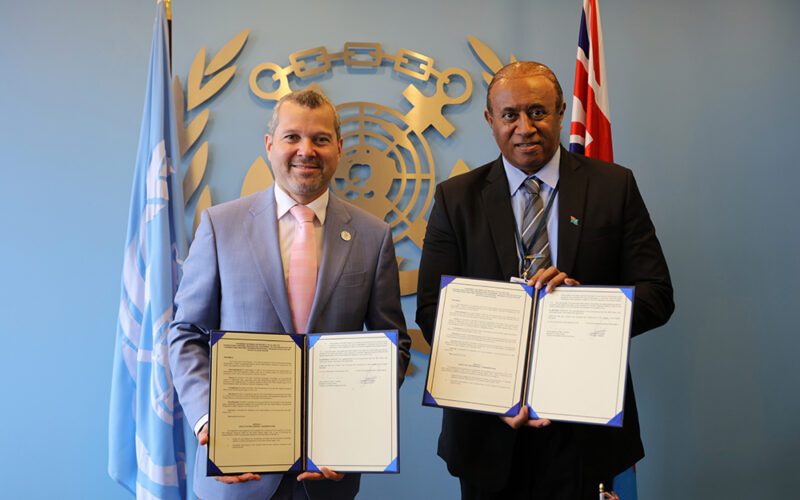The International Maritime Organization is opening a Regional Presence Office in Suva, Fiji to serve countries and territories in the Pacific Islands region. IMO Secretary-General Arsenio Dominguez and Fiji’s Minister for Public Works, Meteorological Services and Transport of the Republic of Fiji, Ro Filipe Tuisawau, signed a Memorandum of Understanding at IMO Headquarters in London on March 18 to seal the arrangement. “The Regional Presence Office will support the maritime needs and priorities of countries in the Pacific Islands region,” the International Maritime Organization explained in a statement, “aligning IMO actions with national and regional development policies, while providing advice…

Setting the Stage The frenzied buzzing of the seaport manager’s cell phone interrupted his weekly staff meeting. There were urgent text messages and voice mails signaling that there was a major problem at Container Terminal 5. One text message said, “Crane 5A has stopped functioning! Crane 5C can’t be stopped! Help!” Apparently when one of the world’s largest container ships containing over 20,000 Twenty-Foot Equivalent Units (TEUs) docked at Terminal 5, all hell broke loose. But why? Even though this is a hypothetical story, the U.S. Government and FBI are worried that such a scenario could come true. On Feb.…

The annual Piracy and Armed Robbery Report of the ICC International Maritime Bureau (IMB) released in mid-January has raised concern over the first successful Somali based hijacking since 2017. The IMB’s annual report recorded 120 incidents of maritime piracy and armed robbery against ships in 2023 compared to 115 in 2022. According to the report, 105 vessels were boarded, nine attempted attacks, four vessels hijacked and two fired upon. Since the number of 2023 reported incidents has slightly increased compared to 2022, the IMB has urged caution for crew safety as the number of crew taken hostage and kidnapped increased…

A new secretary-general has been installed by the International Maritime Organization (IMO), and has announced the members of his leadership team. Arsenio Dominguez became the 10th elected Secretary-General of IMO on Jan. 1. Dominguez, who’s from Panama, succeeded Kitack Lim of South Korea, who was IMO Secretary-General from 2016-2023. Dominguez was confirmed by the IMO Assembly 33rd session, which met in November-December 2023. His initial term is four years, ending Dec. 31, 2027. Dominguez had been director of the IMO’s Marine Environment Division, a post he’d held since January 2022. He joined the IMO Secretariat in 2017 as Chief of…

The maritime industry continues to be a target for cyberattacks. In 2023, the industry witnessed increased cyberattacks, with ransomware and distributed denial of service (DDoS) attacks being the most predominant. We hope to raise awareness about these threats, focusing on the incidents that occurred in 2023, while providing some insights into effective defense strategies. Of note, a useful resource to view a record of global maritime cyberattacks is in the NHL Stenden, University of Applied Sciences Maritime Cyberattack Database at http://tinyurl.com/dejyercr. It’s a free resource that was referred to when preparing this article. Cyberattacks: Financial and Business Consequences An October…

Could 3D printing spare parts soon become commonplace in the maritime shipping industry? There’s a very interesting story recently published by Forbes magazine that indicates that it might be. According to the article, marine industry supply chain and distribution company Thyssenkrupp Materials Services has “invested substantially” in 3D printing technology and has been using it to manufacture critical spare parts faster and cheaper than traditional manufacturing. The company has even dropped 3D-printed parts onto a vessel from a drone, the article states. A huge leap forward when it comes to 3D printing for the maritime industry came in October, when…

“Quishing” and a summary report. Cyber and physical security concerns are still actively in play in the maritime industry. Ships, seaports and supporting organizations are all exposed to cyber-attacks and threats to their physical security. In this column, we examine a new cyber phenomena, followed by a seminal report sponsored by market data firm Thetius, risk management company CyberOwl and international law firm HFW. Phishing and “Quishing” Due to its increasing digitization and connectivity, the maritime sector has become more vulnerable to cyber threats, including phishing and the newly emerging threat of “quishing.” Phishing is a common method used by…

Panama is typically one of the wetter countries in the world due to its tropical climate, but a very unusual occurrence is affecting the Panama Canal during the current rainy season: a severe drought. The drought has already slowed vessel traffic to the U.S. West Coast and is threatening to have an effect on the current peak shipping season, when goods are shipped to North America from Asia in time to be on store shelves for holiday season shopping. Here’s the situation: according to climate scientists, Panama is experiencing its worst drought in over two decades, even though the country…

The maritime industry exists to move goods and people via the oceans, lakes and rivers. These goods range from breakbulk—such as wheat, coal, gravel—to thousands of containers moving high-value cargo. Unfortunately, cargo theft in the U.S. is a $15 to $35 billion enterprise that affects seaports, airports, trucking companies and shipping companies daily. The cargo thefts are not necessarily focused on high-value goods such as semi-conductors and precious metals, but also on food and beverages. For instance, in the Seattle area, one thief posed as a Safeway employee and attempted to steal more than $700,000 of king crab for resale.…

From an air quality and climate pollutant standpoint, the state of California has the cleanest ports in the U.S. The success of these ports’ clean air programs is a function of numerous factors. They include port policies, lease agreements, voluntary measures, regulations and an industry willingness to experiment with a variety of technologies, fuels and operational modifications. Most port-related emission categories are now measured in fractions of a percentage point of total emission inventories – i.e., very small numbers. As an example, nitrogen oxide (NOx) emissions for marine terminal equipment operating in the South Coast Air Basin make up about…

